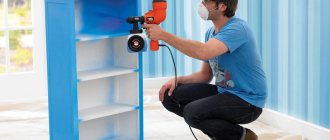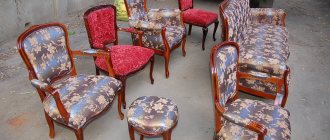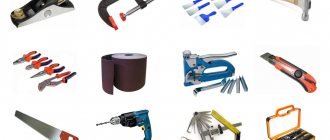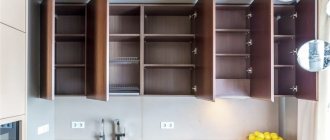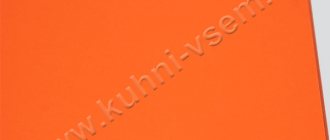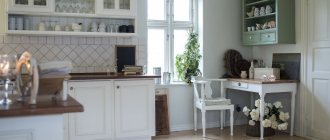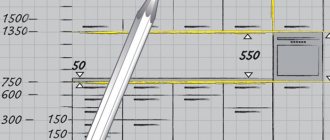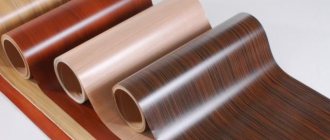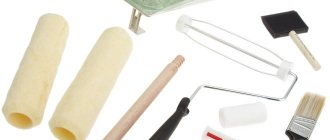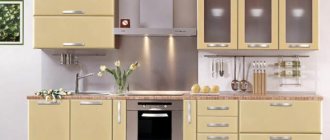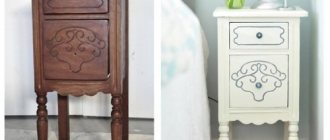The kitchen is the room that falls into disrepair faster than others. Here, furniture and decoration are constantly exposed to temperature changes, high humidity, soot and grease. The facades of the furniture in the work area especially quickly lose their attractive appearance.
Buying a furniture ensemble for the kitchen is not a cheap pleasure. If it is worn out only externally, then you can bring it back to life yourself. What methods of restoring kitchen facades exist and how to work with them - read on.
A simple way to restore furniture facades from MDF
As you all know very well, almost all modern furniture is made from sheet composite materials. Most often, the body of a cabinet or hanging cabinet is made of laminated chipboard, and the facades and countertops are made of MDF.
MDF lends itself perfectly to milling and other types of processing. As a finishing coating for facades, either paint or PVC plastic film is used. Using film, you can create an imitation of the texture of wood, stone, etc. However, the use of such facades (covered with film) in very harsh kitchen conditions often leads to peeling and cracking of the coating. At the same time, the shape of the facades does not change.
In this article, the author of the YouTube channel “Vladimir Natynchik” will tell you how you can restore kitchen facades from MDF.
The proposed method is very simple, and almost anyone can handle it.
Materials. — Automotive putty — Acrylic enamel, varnish — Turpentine, acetone, or gasoline — Plastic film, masking tape — Sandpaper.
If chips or dents are found on the surface of the MDF, they can be easily eliminated using automotive putty, which is what the author did. After the putty has dried, the surface is sanded with sandpaper.
After this, you can take the parts to a furniture factory to re-upholster them with PVC film. However, Vladimir decided to go a different route and simply paint them. This coating is much more durable than film coating.
Before painting, you need to protect the back side of the parts with plastic film and masking tape.
This composite material absorbs paint very well, so it is better to prime it first to avoid unnecessary paint consumption.
The author did not do this; he degreased all external surfaces using purified gasoline, and applied a layer of acrylic paint to the facades of the lower tier. He dyes them dark green and leaves them to dry. A pneumatic spray gun and an air compressor are used to apply paint.
Of course, not everyone has such a device, but you can purchase an electric version. You can also use spray paint in cans.
Then you will need to contact a company that specializes in plotter cutting. Typically this type of work is performed by advertising agencies. They will need to cut out your chosen design of the desired size on the self-adhesive film. By the way, with high-quality plotters the accuracy of the resulting pattern can reach 0.2 mm.
After cutting, you will be given a film with the thinnest slits. The film is removed from elements of the design that require painting. Then a transport film is glued on top (you also need to buy it from the same company), and the stencil is removed from the substrate. Having placed it over the desired part of the facade and carefully glued all the parts, the transport film is removed and a layer of paint of a different color can be applied. If the design will consist of several different colors, then you can protect individual segments with masking tape.
This technique is quite simple, but there should be no dust in the room where painting will be done.
Thank you Vladimir for the easy way to refresh your kitchen interior with your own hands!
Good mood, good luck, and interesting ideas to everyone!
The author's video can be found here.
Source
Unusual solutions
The imagination of home craftsmen literally has no limits, so completely unexpected things can serve as materials for kitchen renovation.
- Photo wallpaper is a material that is in no way inferior to PVC film in terms of density and strength. It is fixed to the surface of chipboard, MDF and even plastic with liquid nails. Photo wallpapers are cut to the size of the facades and pasted in the most usual way. After the glue has dried, the products must be opened with varnish. If desired, you can order photo wallpapers with images from your personal archive.
- Tile finishing. As a rule, walls are decorated with ceramics. However, nothing prevents you from using this beautiful material as decoration for a flat or paneled facade. The tiles are cut and fixed using the same liquid nails.
- An even more interesting, but also labor-intensive option is porcelain mosaic. There are not enough broken dishes from one apartment for this, so you will have to get the fragments somewhere: if you negotiate with the nearest cafes and restaurants, you will get the material quite quickly. The fragments are sorted by color, used to form a pattern or simply a color gradient and glued to the surface of the facade. The gaps between the fragments are sealed with grout.
Restoring kitchen furniture should first of all restore functionality. However, the process is creative and exciting, so that as a result the kitchen can completely change its appearance.
Source: kuhnyamy.ru
Types of coatings
For the kitchen, the best choice would be MDF furniture. And the point is not even in its greater density, but in the high homogeneity of the composition. Unlike chipboard, the material does not crumble and holds fasteners well, even repeated ones, which is extremely important when replacing hinges, handles or other fittings. In addition, the manufacturing method itself is based on lignin, and not formaldehyde resins, which makes MDF facades more environmentally friendly.
In the photo - a kitchen with MDF facades covered with veneer
The slab is decorated in a variety of ways.
- Veneer is a section of natural wood glued to a slab. It requires exactly the same care as a real tree, is just as capricious and just as beautiful. If damaged, this coating cannot be restored with your own hands.
- PVC film is most often used for laminating chipboard, since this is the most budget option. The film can imitate any type of wood, although not entirely convincingly. The main disadvantage is that with prolonged exposure to moisture and temperature, the film peels off. Repair is partially possible.
- Melamine film - its basis is decorative paper impregnated with melamine resin. The advantage of such kitchen facades is their higher resistance to moisture.
- Acrylic film is a paper-laminated plastic, characterized by much higher strength, resistance to mechanical damage and dampness. This coating can have a matte, satin or glossy surface, and therefore extremely rarely imitates wood. Any colors are available - white, red, blue, black and all possible combinations.
The facades of the kitchen in the photo are covered with film.
The undoubted advantage of the three listed film options is the possibility of finishing radius facades. And such a solution always looks original. Moreover, the size and configuration of the kitchen have little effect on the price.
- Acrylic panels - here the color or design, including photo printing, is applied directly to the MDF board and then filled with clear acrylic glass. Such an impeccable gloss enhances any color - white, lilac, crimson. Despite their considerable strength and absolute resistance to moisture and heat, acrylic kitchen panels have a drawback: their restoration if chipped or other damage is impossible - the sash must be replaced. The photo shows a kitchen with a white glossy facade.
Update or replace?
Before making a choice, you need to evaluate the general appearance of the kitchen furniture. If it is of good quality, made of solid wood or MDF, it will be enough to refresh the furniture facades and update the fittings if necessary. If kitchen furniture is made of low-grade materials, then it cannot be restored. Professional restorers will help you assess the complexity of the work and determine the amount of repairs. A consultant from the workshop usually visits your home and offers possible restoration options.
The final decision remains with the customer. Replacing kitchen cabinetry usually costs more than other furniture because it requires very high-quality parts. If the cost of making new handles, hinges and fasteners costs more than a new kitchen set, it would be advisable to replace the old furniture with new ones. However, in most cases, the master manages to revive most of the kitchen fittings, replacing only some parts for ease of use.
Replacing old MDF facades with new wooden ones is a radical decision, but expensive, unless you like carpentry yourself
If everything is fine with the fasteners, then you can give the old kitchen furniture a new look yourself. The easiest way is to replace the doors with new ones, leaving the main part of the furniture in its original form. You can also replace the panel (inner part of the facade) with stained glass, glass with sprockets or sandblasting. There are also the following restoration methods: pasting with vinyl film, painting, decorating with moldings, decoupage, varnishing. Let's take a closer look at each of the methods of furniture restoration.
Film coating repair
Most often, over time or from overheating, the PVC coating can peel off. This happens extremely rarely with melamine film, and even more so acrylic, since their base is paper, which in its properties is much closer to wood-fiber material. In addition, this type of coating is attached under high pressure.
As a result, it is possible to re-tighten PVC film with your own hands, but not melamine or acrylic film.
Repairs of this kind are possible only in small areas and only in cases where the film has only peeled off and has not become deformed, as happens from overheating. In the latter case, it is easier to remove the entire coating or order a new kitchen façade.
To remove the defect, put PVA, “Moment”, “Titan” glue into a medical syringe - without a needle - and carefully fill the cavity under the film. You can also use “liquid nails”. The film is stretched, smoothed so that no air bubbles remain, and secured with tape for 4 hours.
In case of extensive damage, restoration of kitchen facades is impossible.
Interesting ideas
When updating, other methods of decoration are additionally used. They are often combined with the options above :
- Painting . The painting on the doors of the kitchen unit looks beautiful. Designers often create real artistic masterpieces on furniture. You don't have to have artistic talent to decorate your kitchen with paintings. There are many stencils sold in specialty stores.
- Stickers . This is the simplest option for decorating a headset. It looks stylish and unusual. Such decorations are sold in furniture stores and departments of decorative goods. The picture is glued using the same principle as polymer film.
- Mosaic . It is attached to putty or liquid nails. It is recommended to make a wooden frame around such a fragment. The mosaic itself is made from tiles and even broken dishes.
- Panel . In this case, the doors are decorated with stones, dry plants, shells and any other objects suitable for the interior. They are pressed into plaster, which is first applied to the door in a thick layer. The composition is coated with varnish.
Kitchen painting
You can paint MDF facades with everything, with the exception of options with an acrylic panel. This kind of repair requires great care and some experience. Especially if you need to paint a complex surface - milled or radius.
The renovation consists of three stages: choosing paint, preparing and painting.
Selection of paints and varnishes
To paint MDF boards, ordinary acrylic or oil paints can be used. Alkyd compounds are better in quality and more durable. The ideal option for the kitchen are polyurethane paints and our own polyurethane primer.
1. Water-based polyurethane primer is absorbed by the top layer of the material, shrinks the loose surface, imparting sufficient strength and smoothness. This coating is easy to sand and significantly reduces the consumption of paint and varnish.
If fairly old kitchen facades are being repaired, it is highly recommended to apply a second layer of filler primer.
2. Polyurethane enamels are distinguished by a rich range of colors and provide varying degrees of gloss. The following paints are produced:
3. Varnish. Acrylic and polyurethane varnishes are used. The former are transparent and do not turn yellow over time, but are inferior in mechanical strength to polyurethane ones.
Preparation of material
If the facades are really old, the surface includes not only peeling of film and paint, but also chips and cracks.
If the dimensions of the sash have changed, for example due to constant dampness, then it is advisable to abandon the restoration. It will be much faster and cheaper to completely renovate the kitchen.
If you decide to radically change the design of the kitchen, then do-it-yourself renovation is quite possible.
- The hinges and handles are removed from the sash.
- Get rid of the film coating. Since PVC film and melamine film are not resistant to heat, the facades are simply heated with a hairdryer and the film is removed. This cannot be done with an acrylic panel.
- The old layer of enamel is removed with a solvent.
- The surface is polished using sanding sponges, brushes or a sander. The treatment removes glue and paint residues, minor scratches and chips. Grinding is carried out in three stages using abrasive materials with coarse grains - P180, medium and fine.
- Then the part is cleaned of dust and primed. This is best done with a spray, but you can use a roller or even a brush. The primer dries in about 8–10 hours.
- After drying, the surface must be cleaned again with the finest grain abrasive.
The process of preparing the material is covered in detail in the video.
Painting material
You can paint kitchens with a roller or a brush, but it is still better to use a sprayer. This significantly reduces work time and allows you to obtain uniform painting on any surface - flat, milled or radius.
You need to paint in two layers, the second is applied after the first has completely dried. If you use paint and varnish material of the same shade, you can get a uniform matte or glossy surface. However, with the help of enamel you can create more interesting effects.
Preparatory stage
Before the door restoration process begins, it is carefully examined for damage. You should purchase materials and necessary tools only after this stage. It is often impossible to do without veneer paint. It allows you to quickly and effectively eliminate any abrasions.
Many people cannot understand how to update a product with their own hands, since the task is not considered simple. This requires accuracy and certain skills. Repair of veneer doors begins with preparing the surface with special compounds. Use wood putty, which helps to level the canvas and subsequently produce high-quality painting.
Briefly about the types of MDF facades and the possibilities of their repair
MDF board is used as a basis for furniture facades, with a wide selection of possible coatings. The most popular types of MDF kitchen facades include:
- MDF under PVC film . The most inexpensive and practical cladding option. With careful use and timely care it can last for many years. The most common defects are peeling of the film from the base with bubbles, shrinkage of the film at the ends of the facades due to exposure to temperature, scratches and chips due to mechanical stress.
- MDF facade panels Evo Gloss, AGT, Acryline, High Gloss. They are made using different technologies, but, in essence, they look approximately the same. They are MDF panels covered with a decorative film (melamine, PVC, veneer, etc.) with a finishing acrylic coating (the term UV varnish is also used). Glossy façade MDF panels look most impressive, with an almost mirror-like shine and deep, rich color. The material is practically not amenable to restoration. Only small, thin scratches can be sanded and polished without damaging the decorative layer.
- MDF with plastic lining. Today, plastic is the most “vandal-proof” coating option for kitchen facades. A high-quality plastic surface can only be damaged deliberately by sharply hitting or scratching with a sharp object. By analogy with facade panels, plastic MDF facades can be restored only if the decorative layer is not damaged. Otherwise, you will have to match the retouching color and somehow mask the places of chips and scratches.
- Painted MDF facades. The most “long-lasting” and restoreable option for furniture. True, it is not always possible to do this at home and with your own hands - for high-quality restoration and repainting it is better to entrust MDF facades to specialists.
Using heating devices
If the PVC film peels off from MDF kitchen facades, you can try replacing it with a new film or gluing the old material in place using available electrical appliances. This could be an iron, a powerful home or construction hair dryer. The film needs to be carefully warmed up: it should become quite soft and blurry, but not start to melt. If you have something to try, use these pieces or on an inconspicuous place on the façade. The device is pressed against the edge that is not glued for a few seconds. The film should stretch, the glue should warm up at this moment, and the material should protrude towards the back side of the facade and adhere firmly. If this can be done, then it will be possible to glue the entire facade in this way, in places where the film has retreated.
Advice: the film itself cannot be heated with a hairdryer at close range, as this will curl it and be damaged.
This DIY restoration of kitchen facades requires some skill, but is quite simple to perform and does not require the use of expensive tools or materials. If the inside and corners are poorly glued, you can use a metal rod comparable in size to the frame. First you need to warm it up. For this, you can use, for example, a gas burner.
Restoring coating using friction
Restoring kitchen facades from MDF using this method does not require any available tools at all. In order to glue the separated section of the film, you need to cover it with a rag and start rubbing it with your fingers, pressing the film. If there is adhesive underneath, the temperature from friction in a small area will be enough to activate a chemical reaction and cause the film to stick.
Advice: this method should be used carefully, as there is a high risk of damaging the film, exposing its edge or removing the top layer, which will ruin the appearance of the coating.
Application of glue
Restoring a glossy kitchen can cause some difficulties, since gloss does not tolerate strong physical impact, which is why it should not be roughly rubbed with your fingers or heated closely with any appliances. You can try a safer method - gluing the separated film using “Moment”. Most often, such a film peels off in the kitchen, since it is not affected by hot steam. It is necessary to restore the coating as quickly as possible, otherwise the furniture itself will be damaged. The glue must be applied to the untreated area of the facade and to the film itself along the edge so that it can isolate the seam from negative influences. All this must be done carefully, as the glue easily sticks and gets dirty.
Conclusion: inexpensive do-it-yourself kitchen restoration is quite accessible; it is advisable to look at photos of the finished results in advance. With a careful and competent approach, you can easily restore the appearance of the kitchen without resorting to replacing parts and without spending money and completely replace the facades.
What is needed for the restoration of furniture facades and a general plan of action
For the restoration of furniture facades made of chipboard, MDF and natural wood, special restoration materials are used. They can be purchased in online stores of furniture components and accessories, as well as in construction hypermarkets.
Depending on what the furniture facades are made of, restoration means are selected:
- Soft furniture wax, putty, primer. Used to fill cracks, chips and deep scratches.
- Furniture touches, markers and colors . They are needed to shade worn surfaces, paint over scratches and other small chips, and make them invisible.
- Fixing varnishes and polishes. They are used for applying a finishing, fixing coating after the restoration of MDF facades has already been carried out.
The general algorithm of actions when restoring furniture is usually as follows:
- Before restoration begins, furniture fronts and other furniture elements with defects must be removed from their hinges and freed from handles, fittings and decor.
- Then wash thoroughly to remove dirt and degrease. If the chips and scratches are deep enough, they also need to be cleaned as much as possible, freed from detachable particles, and the irregularities carefully sanded off using zero-grit sandpaper and felt pads.
- Next, the defects are filled with primer, wax or putty, depending on the type of material. After drying, a suitable shade of color is selected to match the color of the facade and carefully retouched. A modern assortment of markers and crayons allows you to reproduce even the texture of wood if the restorer has artistic coloring skills.
- After drying, the excess paint is carefully sanded off and polished using special care products. You can use fixing varnishes and furniture polishes.
In addition to restoration materials, you will need cleaning and degreasing agents, a spatula, sandpaper, rags, pieces of felt, and brushes. As well as small hand tools (awl, screwdriver, ruler, pencil, toothpicks) and personal protective equipment.
Sealing holes
In order to remove not a scratch, but a deeper hole, you will need:
The hole should be covered with putty mixed in the correct proportions. Excess material is removed using a spatula. After drying, the area is painted.
Finally
Repairing a door is not an easy task. And if even a beginner in carpentry can handle scratches (with tools, of course), more serious problems will require skill. If you don’t have confidence in your abilities, it’s better to give preference to a master.
Restoration of kitchen facades made of MDF in PVC film
The first thing that should alert you when choosing a kitchen with MDF facades in PVC film is that the price is below the market average. This is the first sign that the production used a cheap thin film (perhaps not even PVC, but melamine, “paper”) and the cheapest glue.
What does this mean for the buyer?
The fact is that during operation the film may begin to peel off from the base and appear in “bubbles”. And also dry out and crack. The surface of the thin film of the MDF facade is easy to damage and is completely scratch-resistant.
What to do if the film on the MDF facade has moved away from the base
If you detect this defect in time, you can “save” your kitchen. To do this, you need to take the most common PVA glue (or bustilate) into a syringe with a thin needle and carefully insert it under the film. The façade must first be removed from its hinges, washed and degreased.
We recommend inserting the needle at an angle so that the hole runs diagonally. If the façade is from the bottom row of the kitchen, then the hole should be directed diagonally downwards, opposite to the viewing angle. And if this is the door from the top cabinet, then, accordingly, the top. This makes it less likely that the hole will be noticeable after restoration.
The amount of glue should be exactly as needed to glue the peeled area. Therefore, there is a reason to introduce it in portions, while simultaneously distributing it under the film by rubbing with a rag.
The restoration of the MDF facade under the PVC film is completed by pressing the freshly glued film with a press until it dries completely. Before doing this, make sure that the film is glued smoothly, without wrinkles or wrinkles.
Restoration of the ends of MDF film facades
Often, on kitchen cabinets and tables adjacent to the stove, due to constant exposure to temperature, the ends of the facades acquire an unaesthetic appearance. The edge on them turns yellow, and the PVC film shrinks, revealing the bare end of the MDF. To prevent this, it is better to immediately protect the ends of the furniture with special metal covers.
If the film on the ends of the MDF facades has simply moved away from the base, then it can be glued using any synthetic glue. The procedure will be similar to those described above: you need to carefully clean the inner surface of possible dirt with a stationery knife, degrease it, and after gluing, press down until the glue dries.
Restoration of scratches and chips on MDF kitchen facades with PVC film
Unfortunately, PVC film has such a texture that when scratched, it stretches a little, compromising the integrity of the façade coating. Such defects cannot be restored, they can only be masked.
For example, manual patination of the facade. Or various decoupage techniques.
Why is this happening
Let's start by examining the reasons why the film on your MDF kitchen facade has peeled off.
This can happen for several main reasons. Next, you will learn what to do in this situation, how to glue it and how to protect the film from the oven and other provoking factors.
- The glue was not applied to the entire surface. If application is done manually, the master may accidentally or deliberately make omissions in order to save money. In these areas, the film adheres less well to the surface;
- The use of cheap adhesives. Alas, everyone’s manufacturing technology is different, and you can often find beautiful kitchens made from materials that are not of the best quality. Typically, films peel off when using simple two-component polyurethane compounds;
- The glue has expired. Using such glue, the film sticks at first, but does not last long;
- Low temperature when installing film. Also, peeling can occur due to a violation of the temperature regime during the gluing process.
In reality there are quite a lot of reasons.
But even on high-quality surfaces, peeling is possible.
This mainly occurs due to the oven and on the facades adjacent to it.
What happens is this: The housewife is preparing some dish in the oven, which is heated to high temperatures. When you take out the dish, all the heat comes out and hits the façade. As a result, the glue melts, loses adhesion to the film, and it peels off.
There is a high probability of peeling off when exposed to sunlight. Gradual heating occurs, the film burns out, the glue dries out or melts. That's it, the grip is lost, and the result is obvious.
To summarize, the following main reasons can be identified:
- glue deficiency;
- low quality glue;
- expired film adhesive;
- mismatch of film and glue (poor adhesion to each other);
- violation of production technology;
- insufficient temperature when gluing the film;
- weak vacuum supply;
- poorly heated film;
- improper use of facades;
- location directly next to the stove;
- exposure to sunlight.
Sometimes there are several causes at once, or only one factor influences.
The result is the same. The film has peeled off and needs to be fixed.
What to do with curved surfaces?
Restoring the coating of corner elements that have a curved shape may at first glance seem more difficult than working with flat surfaces. But semicircular facades are no more difficult to process than all others.
Radial facade can be:
When working with self-adhesive coatings, experts advise applying the film in the direction of the bend, and not across it. This will make the process easier and faster. Working with paint or varnish in this case does not differ from the standard one.
Difficulties may arise with curved glass on the facade. To replace a broken or cracked piece, you will have to order it separately. It is better to entrust measurements to a specialist.
Restoring the façade of a kitchen unit does not cause any problems. In most cases, a home handyman can easily handle it on his own. But in a situation where the damage is extensive, it is better to seek help from specialists. Or consult with an experienced carpenter first.
Source: vseme.ru
Decoupage
To restore the facades of kitchen furniture, sometimes they resort to not entirely traditional methods. Decoupage has become a trendy touch for retro kitchens. But in practice it is used quite rarely, as it requires taste and accuracy in execution.
The material for decoupage is special napkins with bright original images. In fact, in this capacity you can use newspaper clippings, pieces of fabric, fragments of lace, your own old photos, a finished image from albums or books. In the kitchen, decoupage using small objects will be very useful: coffee beans, herb stems and spikelets, dried flowers and the like.
The decoupage technique is quite simple: you sand the kitchen set with your own hands using coarse and then fine sandpaper. They are painted with a background color - acrylic paint is used, and then the image or objects are fixed to the surface using office glue. Be sure to cover the craft with several layers of transparent furniture varnish after the glue has dried.
The photo shows “plant-based” kitchen decoupage.
We use self-adhesive film
Self-adhesive film will help quickly renew shabby tables and worn-out kitchen units made of chipboard. The variety of textures and colors of the material will allow you to create a new style of furniture and fit it into the modern interior of your home.
For work you need to prepare: self-adhesive film, knife, soft rag.
Algorithm of actions:
- furniture unwinds into its component parts;
- surfaces are thoroughly cleaned and degreased.
- Secret: water with the addition of liquid dishwashing detergent will help clean surfaces. A solution with vinegar will help degrease furniture;
- the prepared surfaces are covered with self-adhesive film.
- Important: film cutting is carried out taking into account 10 mm allowances. Before pasting, the furniture is lightly moistened with water from a spray bottle. This will help you easily correct folds and distortions during operation;
- The pasted surfaces are smoothed with a soft cloth. If a bubble remains under the film, puncturing it with a needle will help remove it.
Removing stains
Often on a polished surface there are stains from spilled coffee, iodine, oil, wine or other unknown coloring liquid. You can deal with them by wiping the stains with gasoline.
If necessary, repeat the procedure several times until it disappears completely. Finally, wipe with a mixture of denatured alcohol and linseed oil, this will restore the polish.
Stains from hot mugs, irons, and kettles are removed using ammonia or regular vodka.
